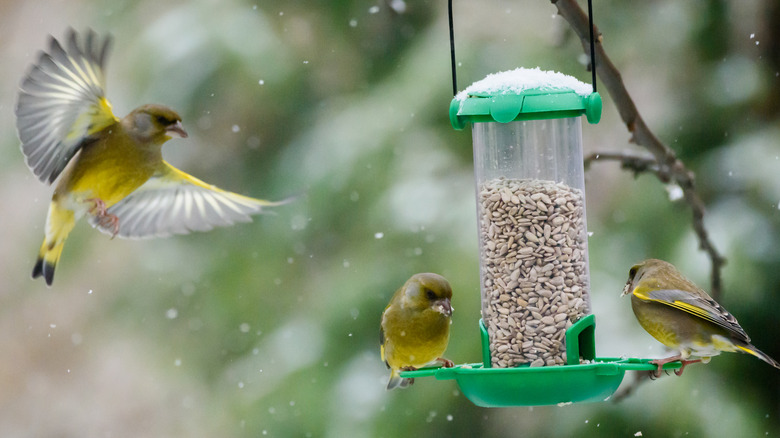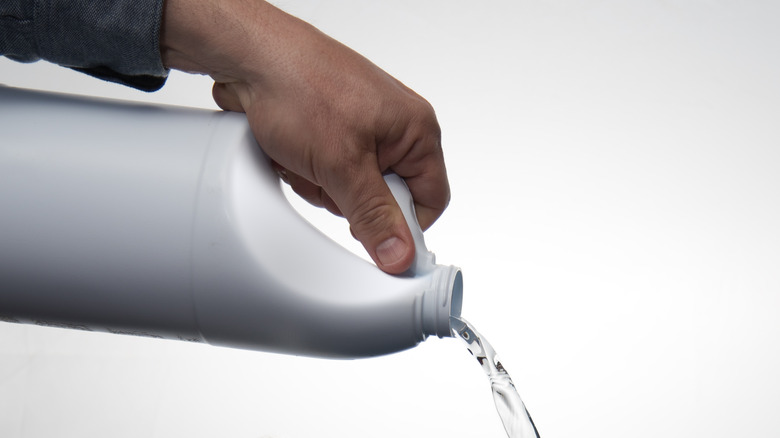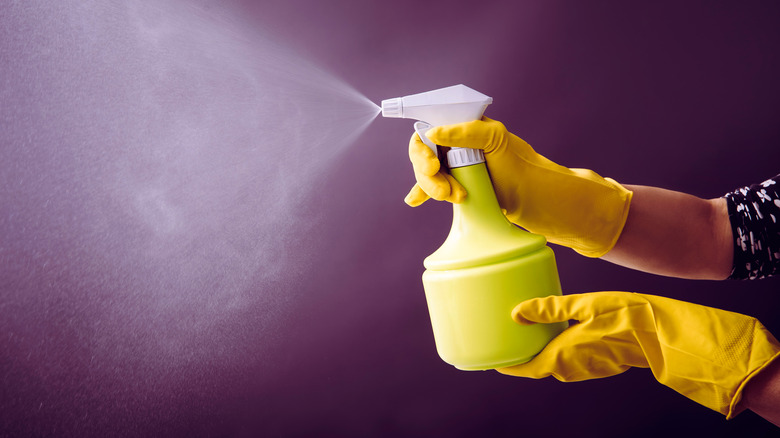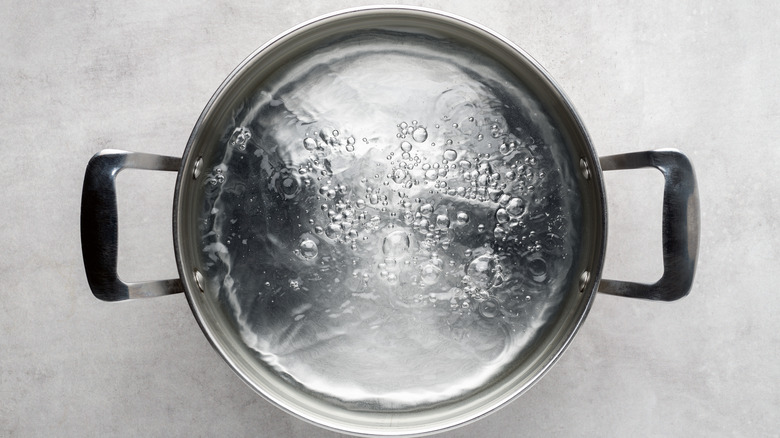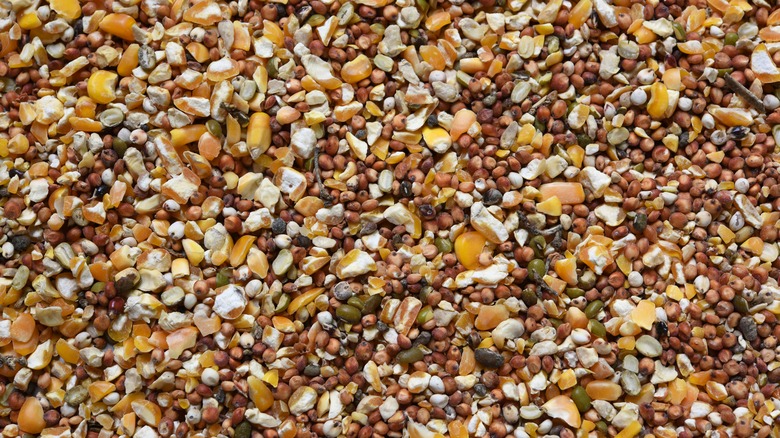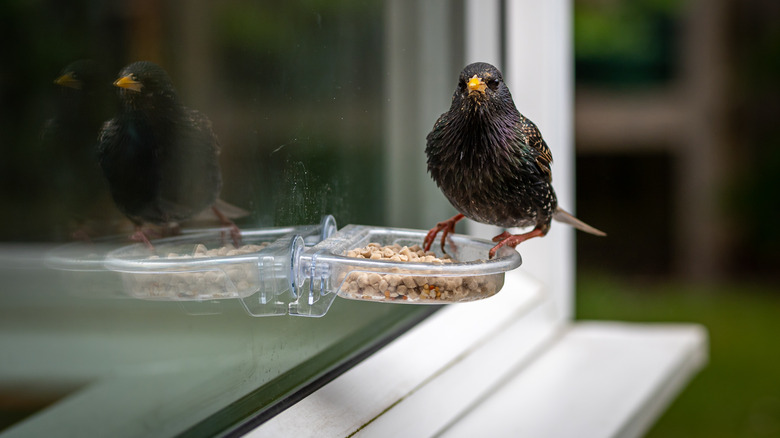How To Properly Clean Your Backyard Bird Feeder
There's no better way to start your morning than listening to the chirping of happy birds in your backyard, and it's all thanks to your bird feeder. Not only are you keeping local wildlife adequately nourished, but you are also inviting happiness into your life with every tweet. However, that doesn't mean bird feeders don't come with their own challenges. According to the Georgia Department Of Natural Resources, if a bird feeder isn't properly cleaned, our winged friends can contract several life-threatening diseases, including salmonella, avian pox, trichomoniasis, finch disease, and more.
Birds can catch these diseases in a variety of ways, but the most common is by eating food or drinking water that's been polluted by the infected ones. They can also contract an illness by direct contact with one another and by eating moldy seeds. Thankfully, there are methods to keep you and these lovely creatures safe and disease-free. All you need are a few household ingredients and a watchful eye.
Bleach
As we all know, bleach is a key player in cleaning and sanitizing surfaces. Bleach can kill 99.9% of bacteria in as little as 10 minutes, according to a 2014 study by the World Health Organization. Because of its strong bacteria-killing power, Audubon recommends completely disassembling your bird feeder and soaking it in a mixture of nine parts water to one part bleach. If you notice any dirt or debris, be sure to scrub it off before submerging the bird feeder in the bleach solution. Let the feeder sit for 10 minutes; however, if your feeder needs a deep clean, wait 30 to 60 minutes.
To avoid buildup and harmful bacteria, take the time to properly clean your backyard bird feeder every two weeks. If you notice them more often and have concerns about potential mold growth, increase the frequency of your cleaning. We can assure you that the birds will be very thankful.
Vinegar
Vinegar is also a strong contender to ensure your bird feeder is appropriately cleaned. Unfortunately, according to the Force of Nature, vinegar doesn't have the power to disinfect or kill bacteria, but it can disintegrate and remove the mold lingering in your backyard bird feeder. Before you clean your feeder with vinegar, it's crucial you remove all the bird seeds and their seed hulls, which is the seed's outer shell. Properly dispose of them in the trash where the winged creatures and other wildlife won't have access to them.
To apply the vinegar method, you'll need undiluted white vinegar and a spray bottle, says the Merry Maids. Remember to protect yourself using non-porous gloves. Saturate the mold with the vinegar and let it sit for a minimum of 60 minutes. After the 60 minutes have elapsed, spray the feeder with a solution of ½ teaspoon baking soda and 2 cups of water, then scrub until all the mold is gone.
Soap and boiling water
If your goal is to avoid cleaning your bird feeder without any harsh chemicals or other abrasive methods, washing it with a dish or hand soap may be an excellent method to consider. But before doing any soaking, scrubbing, or rinsing, take the bird feeder completely apart. Doing so will prevent missing any bacteria lurking in the unseen parts of your feeder. The Australian Academy of Science says germs can live longer on smoother surfaces, and this is especially true for your backyard bird feeder.
To ensure your bird feeder is germ-free, clean each part with either hand or dish soap and boiling water — be careful you don't stick your hand in the solution before it's cooled. The New York State Department of Health says boiling water can kill bacteria, viruses, and other pathogens, which are exactly what inhabit your bird feeder and must be eliminated.
Tend to surrounding areas
As you're cleaning your bird feeder, there's a good chance you're solely focusing on the feeder itself; however, keeping the area surrounding your bird feeder is just as important, the Georgia Department Of Natural Resources explains. Be careful not to let seeds and their hulls collect underneath the feeder. When seeds and hulls get wet, they become more susceptible to growing toxic mold. That mold eventually produces spores, which can kill a bird if ingested. The best way to prevent this is to immediately dispose of all seeds and hulls.
To rid the ground below your feeder of these potentially harmful seeds, the Georgia Department Of Natural Resources recommends raking the area once a week to avoid buildup. Place the seeds and hulls in a plastic bag and dispose of them in a tightly-sealed trash can. It's also a good idea to switch up the feeder's location now and then.
When to clean your bird feeder to keep birds happy and healthy
Regular cleaning of bird feeders is essential to ensure the health and safety of the birds that visit your garden. For seed feeders, as mentioned before it's recommended to clean them at least every two weeks. However, during rainy seasons or if the seeds appear wet, cleaning should be more frequent. Nectar feeders, which are typically for hummingbirds, require cleaning twice a week in warmer weather, then just once a week when it becomes cooler. The nectar should be changed even if it hasn't been consumed to avoid mold and fermentation. If there's any indication of mold or if there's a rancid smell, clean the feeder immediately. Lastly, fruit feeders should be kept clean at all times, ensuring no mold or spoiled fruit remains.
There are also specific signs indicating when a bird feeder needs cleaning. Mold growth is a clear indication, especially if moldy seeds are spotted. Any foul or fermented smell coming from the feeder indicates it's time for a clean. Keep an eye on bird activity too. A sudden decrease in bird visits could hint at a dirty feeder. Furthermore, if there are visible bird droppings or any other contaminants on the feeder, it should be cleaned immediately.
A useful tip for cleaning is to use a solution of one part bleach to nine parts water. After cleaning, ensure the feeder is rinsed thoroughly. Regular maintenance not only promotes bird health but can also attract a diverse range of birds to your garden.
